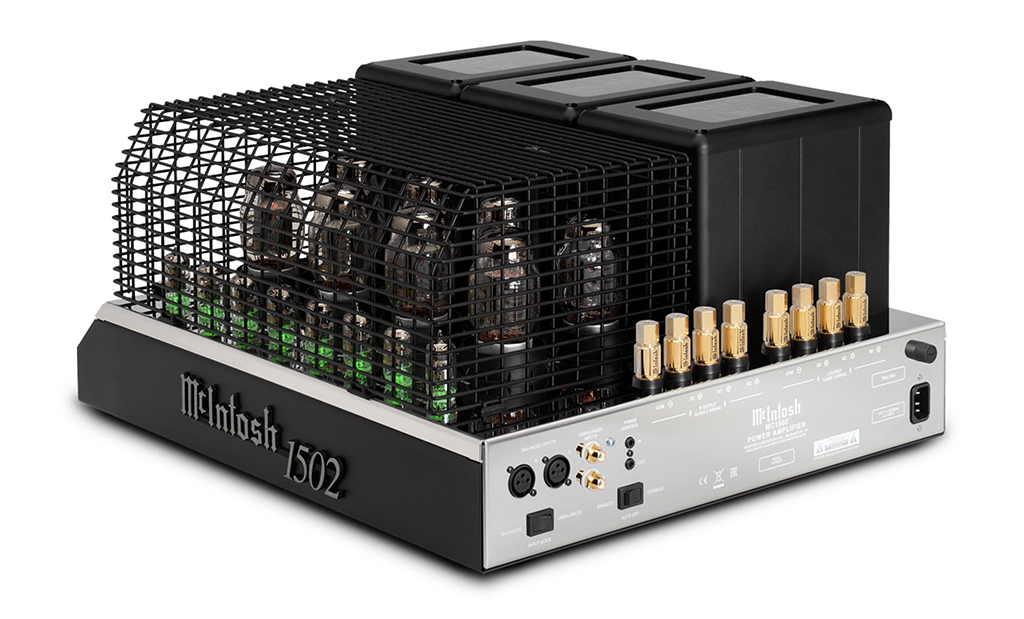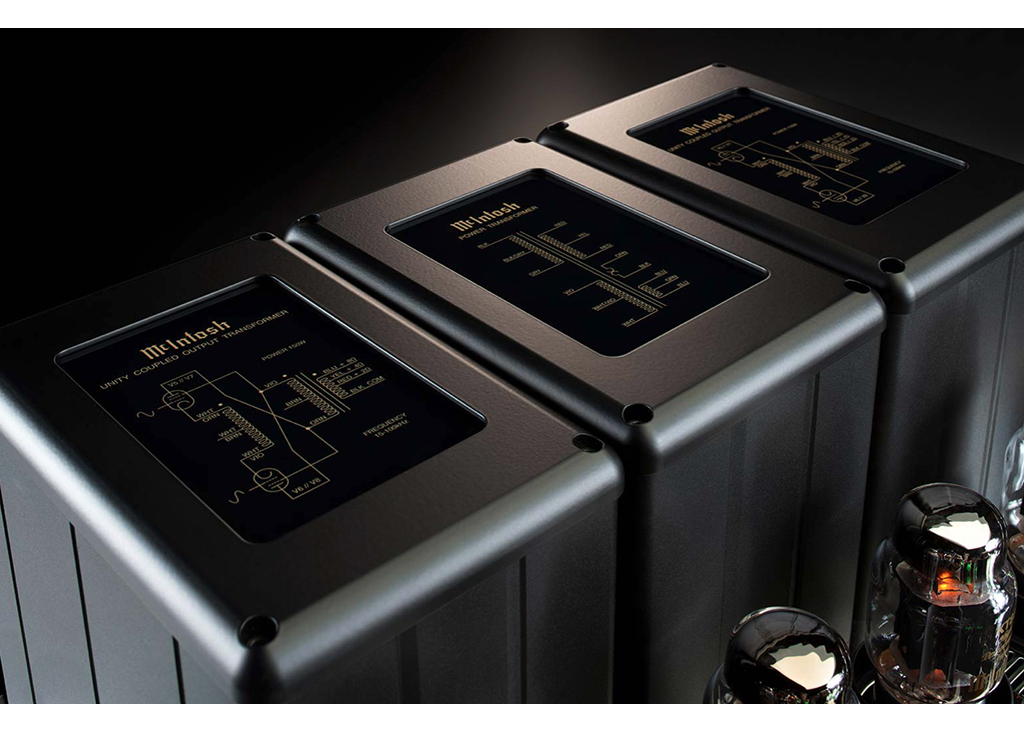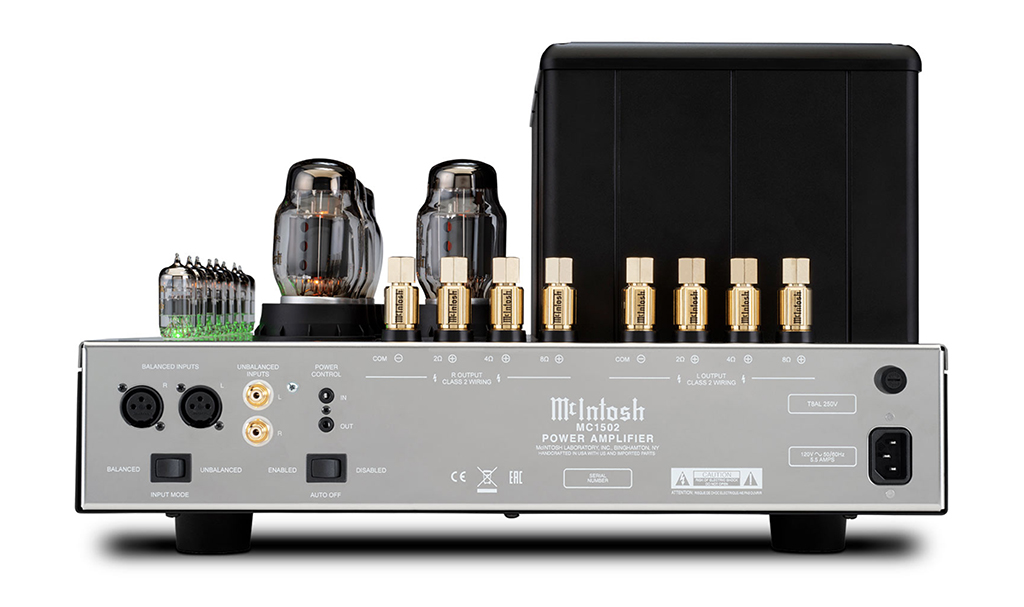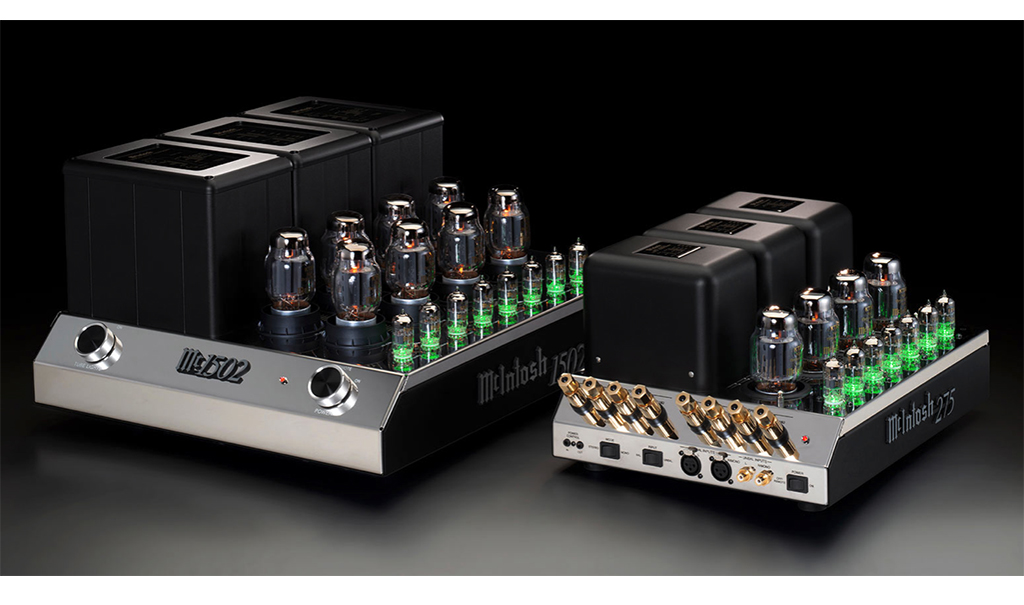The McIntosh MC1502 Power Amplifier Big Mac
By Jeff Dorgay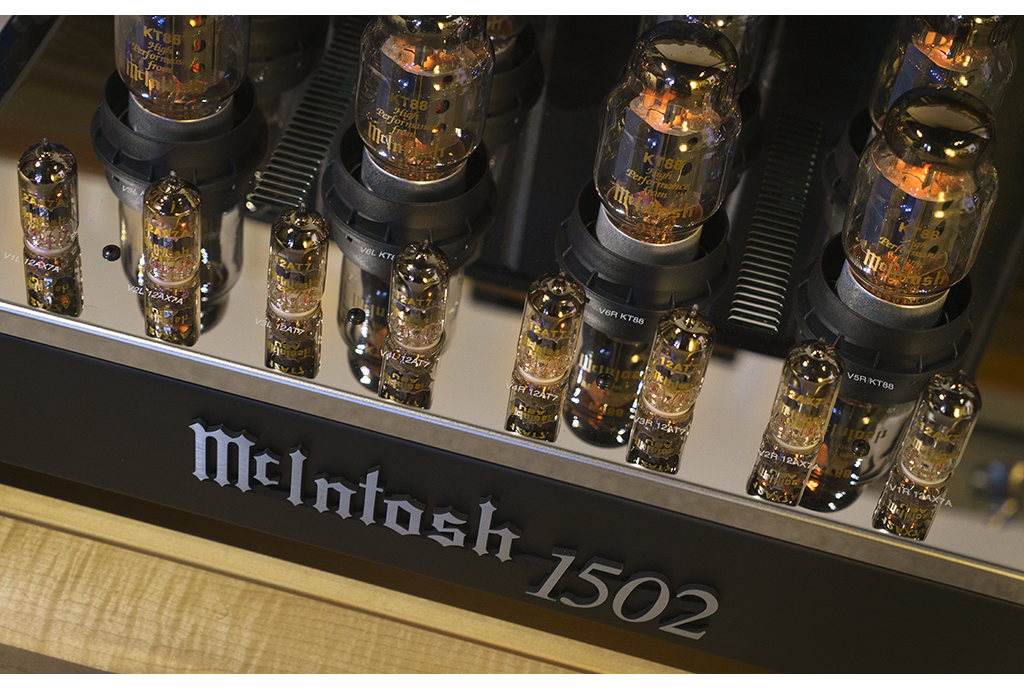 Much as I like to dismiss measurements when it comes to the subject of hifi, there’s one that I find intriguing – sound pressure level, which relates closely to dynamics.
Much as I like to dismiss measurements when it comes to the subject of hifi, there’s one that I find intriguing – sound pressure level, which relates closely to dynamics.
Much as I like small Class A solid-state amplifiers, SET tube amplifiers, and small tube amplifiers like the hallowed MC30 amplifiers from McIntosh – there’s no substitute for power. And in this case the new MC1502 delivers incredible dynamic range.
Listening to The System’s hit, “Don’t Disturb This Groove” at a modest level of about 82 db, I’m surprised to see that the sound level app on my phone is recording 112 db peaks. Meanwhile the softest parts of this track fall all the way down to 55 db, with the room going “silent” at 29db. Even with somewhat compressed Motown tracks, Diana Ross’ lead vocal in “Standing at the Crossroads” Jumps up 20db with ease. Switching back and forth between the 1502 and an MC275 feels smaller, significantly smaller, and the MC275 is no slouch. But the meter doesn’t lie. With levels matched, the same tracks hit much lower instantaneous peak levels, even though average levels are exactly the same.
You might be surprised at how much of the music you feel is unlistenable because you find it overly compressed, is actually running your amp and speakers out of power. Your room size, and speaker sensitivity will play a big part in this, but again, 82db isn’t exactly concert hall levels. Even turning the volume down lower to a 76db average level, is still generating 100db peaks on a lot of tunes. The 150 watts per channel that the MC1502 deliver comes in handy, and at much lower listening levels than you might think.
Racy carbon fiber or traditional Mac?
Anyone digging the matte black and carbon fiber look of the 70th anniversary MC2152 might still be lucky enough to snag one, albeit at a higher price of $15,000. It offers a slightly sleeker, look and has its controls oriented front to back, instead of side to side, as the MC1502 does. But it doesn’t sound any different. The $11,000 MC1502 is a stone cold bargain at that rate, and if you’re a Mac loyalist, maybe take the change and put it towards a C22 preamplifier. That’s where I’m headed.
Whichever direction you choose, unless you are really buff, get a friend to help you lift it out of the box. Packed, the MC1502 weighs 135 pounds, and unboxed, 118. A discussion with the urgent care doc about being careful nicked $800 out of the C22 fund, so proceed with caution. It’s not the lifting the 118-pound amp that gets you into trouble, it’s the trying to gently wiggle it into the equipment rack that will bite you.
And make sure to have plenty of space above wherever you place your MC1502. 8 KT88 power tubes throw off a fair amount of heat. You’ll notice that the MC1502 arrives with a tube cage in place, holding the shipping foam over the tubes. Throw that stuff in the packing carton and forget about it. You wanna see those tubes in action, which leads us to another nice touch.
For some time now, Mc gear has had green lights behind the tubes, so all the tubes glow green. I think the person that suggested this feature should be punished, but it’s still a free country for a little while. The MC275 requires making a small 1/8” jumper to plug into the remote power socket to disable these green lights and allow you to enjoy the tubes in their natural hue. The MC1502 lets you control this from a control knob on the right side of the amplifier. If the person that added this feature to the 1502 is the same person that came up with the green LED thing, rest easy. I won’t fire you when I am the next owner of McIntosh.
But you know what’s super cool? When the 1502 powers up from cold, the two middle driver tubes light up, then another pair, then another, then the final two. Oh yeah. That’s just vacuum tube awesomeness. Roon somehow senses that this is the time for more cowbell and plays “Don’t Fear the Reaper.” Life can’t get much better than this. The rest of the tube complement consists of four 12AX7 and four 12AT7 tubes. That makes for a total of 16 tubes. That’s a lot of tubes to tube roll if you feel so inclined. Fortunately, McIntosh amplifiers are really easy on tubes, and they sound great with the stock tubes. That being said, the area of my brain often overtaken by OCD behavior knows that the MC275 did reveal even more sound with premium tubes. I’ll leave you to your own madness.
All things big and small
Extended listening reveals that this amplifier is just as good at low volumes as it is pushed to its limit – which it does with tremendous composure. Many of the McIntosh owners I’ve met over the years really like to rock, and this amplifier indeed does that. Our Sonus faber Stradiveri speakers are fairly sensitive at 92db/1-watt, so playing music loud was easy. My ears gave up before the MC1502 could clip to the point where the soundstage collapsed.
Actual component break in was minimal. The MC1502 sounds good straight out of the box, and after about four solid days of listening had opened up the last bit, so this isn’t one of those fussy “needs 600 hours to sound right” amplifiers. Dig in and get to it right away. However, the MC1502 does need a solid hour to fully warm up, stabilize, and give its best performance. The first five minutes are compressed, and for the next hour, it slowly comes out of the fog in a linear fashion.
In addition to sounding great at high and low volumes, the MC1502 handles the most densely packed and technically challenging recordings with ease. Part of this delicacy is just what you get with tube amplification, yet auditioning recordings with a lot of percussion or acoustic guitars gives up that airiness and speed that tube aficionados will enjoy.
It’s always tough to get everything with a tube amplifier, but the MC1502 does an incredible job at an approachable price. There’s those transformers again. If you aren’t familiar with tube amplifiers on a regular, and you’ve heard other audio enthusiasts talk about the “warmth” that tubes provide – some of that is many tube amplifiers lack of control over the lowest bass frequencies. Or a softness in the highest frequencies.
The MC1502 takes charge of the lower register as well as or better than any high power tube amplifier we’ve had the opportunity to review in the past 17 years, and the overall tonal balance is slightly warm, with a moderate amount of tonal saturation as well. Yet there is a high level of resolution, which will allow you to peek way into your favorite recordings. This is not your grandfathers McIntosh – it’s a thoroughly modern amplifier.
Price, performance and heritage
There’s no doubt McIntosh makes great gear. And while they offer a wider range of product offerings than at any time in the company’s history, I submit they still rule when in the domain that put them on the map – building high quality tube amplifiers. Maybe I’m a little biased.
Walking through the McIntosh facility, you’ll make your way to a group of people that wind the output transformers for McIntosh amplifiers. Most of the people assigned to this critical task have been doing it for decades. High quality output transformers are the key to great tube amplifier performance. Most of the companies that make the world’s finest tube amplifiers wind their own, and keep the design parameters, as well as the winding technique top secret. All of these amplifiers have much higher price tags than McIntosh. 70 plus years of manufacturing allows not only an economy of scale, but an economy of process and refinement to manufacturing technique.
As mentioned earlier, the MC1502 has the same form factor that Mc tube amps have used for decades. They feature a polished stainless chassis, with transformers at the rear, and tubes up front, displayed for maximum effect. The front panel shows off the McIntosh logo proudly. A quick look at McIntosh tube amps new and old illustrates just how much refinement has gone into these designs. Long gone is the barrier strip for connecting speakers (making way for the sheer girth of today’s audiophile cables), input level controls, and we see balanced as well as single ended RCA inputs. Those of you with multi components systems can control power up remotely via the 12v trigger port. Inputs and outputs are both on the left side of the chassis, however the stereo/mono switch from the MC275 is absent. This is a 150 watt per channel stereo amplifier. That’s it.
One of the biggest questions
Chatter on the internet suggests you don’t need an MC1502 – you can just bridge a pair of MC275s. You can do that- however the results are different. Kudos to McIntosh for offering you a way to merely add another amplifier, and it’s not a dreadful way to go, but having a pair of bridged MC275s reveals enough of a difference, I suggest selling your MC275 (or just moving it to another room and building another Mac system!) and upgrading to an MC1502.
The McIntosh website suggests this is a better approach, because the new amplifier has a lower signal to noise ratio. Comparing a pair of bridged MC275s to the new MC1502 with a number of different speakers all reveals the same thing. The MC1502 has a cleaner, less cloudy, if you will presentation. The bridged MC275 sound great, until you swap the MC1502 into the system, and the effect is there just as much at low volumes, playing acoustic or vocal music as it is playing heavy rock. Talented as the Mc transformer people are, I doubt the output transformers in the MC275 are matched to a zero tolerance, because most people aren’t bridging them.
Once again, Roon anticipates my mood, playing Hall & Oates “Possession Obsession,” and I’m starting to get a little creeped out. But this is a case where trading up is a great thing. Thanks to the incredible loyalty of McIntosh owners, their products barely depreciate. These days, a nice used MC275 is trading for close to retail price, so you won’t lose much money trading up. Who knows, maybe your local Mc dealer will hook you up? All kidding aside, if you want bigger power, make the jump to the MC1502, you won’t be unhappy. However, as I like to say, I love to spend your money.
Final setup, listening, and tech notes
Once you’ve hoisted the MC1502 into place, the rest is easy. Thanks to RCA and balanced inputs, it will integrate into any system with ease. Again, if you’re all Mac, you’ve already got the rest of this figured out and it’s a plug and play operation. During the course of the review session, we made it a point to use the MC1502 with our reference Pass XS PRE, as well as the Backert Labs Rhumba, BAT REX, the Nagra Classic Pre, and a vintage Conrad-Johnson PV-12. All perfection, and the MC1502 has more than enough resolution and tonal purity to reveal the subtleties between all of these preamplifiers.
Thanks to auto biasing, you’ll never have to mess with setting the tube bias, and thanks to McIntosh’s Sentry Monitor circuity, the amplifier is automatically shut down in the event of tube failure. Should this happen to extreme clipping, or a short in the output terminals, the tubes will go from their standard green or amber to bright red. At this point, shut it off for a minute or two and reboot. McIntosh always runs their tubes well beneath maximum design limits, resulting in long tube life. I suspect that the MC1502 will be as easy on tubes as past McIntosh amplifiers I’ve owned, and with more power on tap, you might not find yourself cranking this one up as much to get the desired effect.
You can get all the specs for the MC1502 here, but this amplifier is quiet. There are plenty of solid-state amplifiers that aren’t this quiet. All the audiophile clichés apply here. Should you have fairly sensitive speakers, you will appreciate this aspect of the MC1502. While working on issue 107s speaker roundup, the 97db/1-watt Zu Dirty Weekends reveal less than quiet amplifiers immediately, and thanks to the ultra low noise floor of this amplifier, delivered a stunning performance.
It never hurts to have about 20 speakers at your disposal for a speaker roundup to really give an amplifier a thorough investigation. Everything in house delivered great results, however the MC1502 delivered amazing results with the new Harbeth C7ES3-XD, and the Harbeth/Mc combination is not usually two great tastes that taste great together. Again, that extra current and bigger power supply equals control, and that almost always equals great sound.
In the end, fantastic
Tube amplifiers aren’t for everyone, but the McIntosh has gone above and beyond expectation to bring us an amplifier that produces plenty of power, sounds fantastic, and is well built. Thanks to the auto bias circuitry and anticipated long tube life, this is as easy as it gets to live with a tube amplifier.
The highest compliment I can give the MC1502 is that I’m selling my beloved MC275 and buying a rack with a bigger lower shelf. It’s a keeper. – thanks to McIntosh Laboratory for additional photos.
Peripherals
Analog Source Grand Prix Audio Parabolica Turntable/TriPlanar/Lyra Atlas
Digital Source dCS Vivaldi One
Preamplifier Pass Labs XS Pre
Phonostage Pass Labs XS Phono
Cable Cardas Clear




